Lawrence B Rhodes
age ~76
from Livermore, CA
- Also known as:
-
- Lawrence Bryce Rhodes
- Lawrence E Rhodes
- Larry B Rhodes
- Lawrence B Hair
- Lawrenc Rhodes
- Phone and address:
-
1061 Florence Rd, Livermore, CA 94550
925 449-7302
Lawrence Rhodes Phones & Addresses
- 1061 Florence Rd, Livermore, CA 94550 • 925 449-7302
- Pleasanton, CA
- Ithaca, NY
- Bellevue, WA
Name / Title
Company / Classification
Phones & Addresses
Ed Locksmith
Locksmith
Locksmith
1010 1 Ave, Seattle, WA 98104
206 777-6222
206 777-6222
Resumes

Lawrence Rhodes
view source
Lawrence Rhodes
view source
Lawrence Rhodes
view source
Lawrence Rhodes
view source
Lawrence Rhodes
view source
Lawrence Rhodes
view sourceUs Patents
-
Method And Apparatus For Acquiring Heat From Multiple Heat Sources
view source -
US Patent:7305829, Dec 11, 2007
-
Filed:May 7, 2004
-
Appl. No.:10/841845
-
Inventors:Mark D. Mirolli - Redwood City CA, US
Lawrence Rhodes - Livermore CA, US
Yakov Lerner - Foster City UT, US
Richard I. Pelletier - Livermore CA, US -
Assignee:Recurrent Engineering, LLC - Palo Alto CA
-
International Classification:F01K 25/06
-
US Classification:60649, 60651, 60653, 60671, 60676
-
Abstract:The present invention relates to systems and methods for implementing a closed loop thermodynamic cycle utilizing a multi-component working fluid to acquire heat from two or more external heat source streams in an efficient manner utilizing countercurrent exchange. The liquid multi-component working stream is heated by a first external heat source stream at a first heat exchanger and is subsequently divided into a first substream and a second substream. The first substream is heated by the first working stream at a second external heat source stream at a second heat exchanger. The second substream is heated by the second working stream at a third heat exchanger. The first substream and the second substream are then recombined into a single working stream. The recombined working stream is heated by the second external heat source stream at a fourth heat exchanger.
-
Method And Apparatus For Acquiring Heat From Multiple Heat Sources
view source -
US Patent:8117844, Feb 21, 2012
-
Filed:Jul 17, 2007
-
Appl. No.:11/779013
-
Inventors:Mark D. Mirolli - Redwood City CA, US
Lawrence Rhodes - Livermore CA, US
Yakov Lerner - Foster City UT, US
Richard I. Pelletier - Livermore CA, US -
Assignee:Recurrent Engineering, LLC - Kennett Square PA
-
International Classification:F01K 25/06
-
US Classification:60649, 60653, 60651, 60671
-
Abstract:The present invention relates to systems and methods for implementing a closed loop thermodynamic cycle utilizing a multi-component working fluid to acquire heat from two or more external heat source streams in an efficient manner utilizing countercurrent exchange. The liquid multi-component working stream is heated by a first external heat source stream at a first heat exchanger and is subsequently divided into a first substream and a second substream. The first substream is heated by the first working stream at a second external heat source stream at a second heat exchanger. The second substream is heated by the second working stream at a third heat exchanger. The first substream and the second substream are then recombined into a single working stream. The recombined working stream is heated by the second external heat source stream at a fourth heat exchanger.
-
Gland Leakage Seal System
view source -
US Patent:8375719, Feb 19, 2013
-
Filed:May 10, 2006
-
Appl. No.:11/382606
-
Inventors:Lawrence Rhodes - Livermore CA, US
Yakov Lerner - Foster City CA, US -
Assignee:Recurrent Engineering, LLC - Draper UT
-
International Classification:F01K 13/02
-
US Classification:60646, 60649, 60651, 60671, 60657
-
Abstract:The present invention is directed to a turbine seal system. The turbine seal system captures working fluid which is escaping from a closed loop thermodynamic cycle system, condenses the captured working fluid, and returns the condensate back to the thermodynamic cycle system. The turbine seal system is configured to apply nitrogen, or other non-condensable, or other material, to capture or mix with the escaping working fluid. The combined mixture of working fluid which escapes the turbine and the nitrogen utilized to capture the working fluid is evacuated by an exhaust compressor which maintains a desired vacuum in a gland seal compartment of the turbine seal. The combined mixture can then be sent to a condenser to condense the working fluid vapor and evacuate the non-condensables, forming a working stream. Once the non-condensables have been evacuated, the working stream is pumped to a higher pressure, and prepared to be re-introduced into the thermodynamic cycle system.
-
Scanning Electron Microscope Fabrication Of Optical Gratings
view source -
US Patent:39611027, Jun 1, 1976
-
Filed:Sep 13, 1974
-
Appl. No.:5/505642
-
Inventors:Joseph M. Ballantyne - Ithaca NY
Chung L. Tang - Ithaca NY
Lawrence Bryce Rhodes - Ithaca NY
John J. Turner - Ithaca NY
Ji Liang Yang - Ithaca NY -
Assignee:Cornwell Research Foundation, Inc. - Ithaca NY
-
International Classification:B05D 306
-
US Classification:427 43
-
Abstract:A method of making optical gratings by the use of a Scanning Electron Microscope wherein (1) a substrate having a thin film of electron resist thereon is exposed in adjacent areas by an electron dosage and the amount of such dosage and the depth of the thin film are selected such that energy deposition in regions between adjacent exposed areas in said electron resist is below the threshold sensitivity of said resist for development, (2) the development time of the resist is made an inverse function of the electron dosage, and/or (3) the period of the grating is controlled by use of a standard scanning format.
-
Method And Apparatus Of Converting Heat To Useful Energy
view source -
US Patent:59539186, Sep 21, 1999
-
Filed:Feb 5, 1998
-
Appl. No.:9/019476
-
Inventors:Alexander I. Kalina - Hillsborough CA
Richard I. Pelletier - Livermore CA
Lawrence B. Rhodes - Livermore CA -
Assignee:Exergy, Inc. - Hagward CA
-
International Classification:F01K 734
-
US Classification:60653
-
Abstract:A method and apparatus for implementing a thermodynamic cycle. A heated gaseous working stream including a low boiling point component and a higher boiling point component is separated, and the low boiling point component is expanded to transform the energy of the stream into useable form and to provide an expanded relatively rich stream. This expanded rich stream is then split into two streams, one of which is expanded further to obtain further energy, resulting in a spent stream, the other of which is extracted. The lean unexpanded stream and the spent rich stream are then combined in a regenerating subsystem with the extracted stream to reproduce the working stream, which is then efficiently heated in a heater to provide the heated gaseous working stream that is separated.
-
Converting Heat Into Useful Energy Using Separate Closed Loops
view source -
US Patent:58229906, Oct 20, 1998
-
Filed:Feb 9, 1996
-
Appl. No.:8/598950
-
Inventors:Alexander I. Kalina - Hillsborough CA
Lawrence B. Rhodes - Livermore CA -
Assignee:Exergy, Inc. - Hayward CA
-
International Classification:F01K 2506
-
US Classification:60649
-
Abstract:Converting heat in a primary fluid (e. g. , steam) to useful energy by multistage expansion of the primary fluid, heating of a multicomponent working fluid in a separate closed loop using heat of the primary fluid, and expansion of the multicomponent working fluid. The primary fluid in a vapor state is expanded in a first stage expander to obtain useful energy and to produce a partially expanded primary fluid. The partially expanded primary fluid stream is then separated into liquid and vapor components and split into a vapor stream (which is expanded in a second stage expander) and a further primary stream (which used to heat the multicomponent working fluid).
Myspace
Youtube

Lawrence Rhodes
view source
Lawrence Rhodes
view source
Lawrence Rhodes
view source
Lawrence Rhodes
view source
Search Names Lawrence Rho...
view sourceClassmates

Lawrence Rhodes
view sourceSchools:
Swink High School Swink CO 1974-1978
Community:
Rick Leiphardt, Rudy Baca

Lawrence Rhodes
view sourceSchools:
Unionville High School Unionville MO 1968-1972
Community:
June Schoneweather, Jane Perkins, Randy Mccormack, Kathleen Robbins, Charlene Smith, Terry Donohue, Greg Howard, Lotis Smith, Susan Whitacre, Karen Alexander, C C

Lawrence Rhodes, Bosque f...
view sourceLawrence Rhodes 1987 graduating class of Bosque Farms Elementary School in Bosque farms, NM

Lawrence Rhodes, Pasadena...
view sourceLawrence Rhodes 1964 graduating class of South Houston.High in Pasadena, TX

Swink High School, Swink,...
view sourceGraduates:
Lawrence Rhodes (1974-1978),
Juli Matern (1967-1980),
Karen Blasdel (1973-1977),
Stephanie Lowe (1980-1991),
Mary Carnes (1974-1977),
Elizabeth Matern (1978-1982)
Juli Matern (1967-1980),
Karen Blasdel (1973-1977),
Stephanie Lowe (1980-1991),
Mary Carnes (1974-1977),
Elizabeth Matern (1978-1982)

Berwick High School, Berw...
view sourceGraduates:
Cherie Terrebonne (1991-1995),
Lawrence Rhodes (1964-1967),
Yvette Heathman (1986-1986),
Melissa Briggs (1989-1993)
Lawrence Rhodes (1964-1967),
Yvette Heathman (1986-1986),
Melissa Briggs (1989-1993)

Bosque Farms Elementary S...
view sourceGraduates:
Emilia Emilia Baca (1934-1940),
Lawrence Rhodes (1983-1987),
Brian Alcorn (1975-1976),
Caitlin Medlicott (1994-1998),
Kenneth Abeita (1991-1995)
Lawrence Rhodes (1983-1987),
Brian Alcorn (1975-1976),
Caitlin Medlicott (1994-1998),
Kenneth Abeita (1991-1995)

Pacifica High School, Pit...
view sourceGraduates:
Cassie Gonzales (1968-1972),
Fran Sanchez (1959-1963),
Cindy Duer (1963-1966),
Lawrence Rhodes (1966-1970)
Fran Sanchez (1959-1963),
Cindy Duer (1963-1966),
Lawrence Rhodes (1966-1970)
Googleplus

Lawrence Rhodes (Moosenuts)

Lawrence Rhodes

Lawrence Rhodes

Lawrence Rhodes

Lawrence Rhodes

Lawrence Rhodes
Flickr
Get Report for Lawrence B Rhodes from Livermore, CA, age ~76













